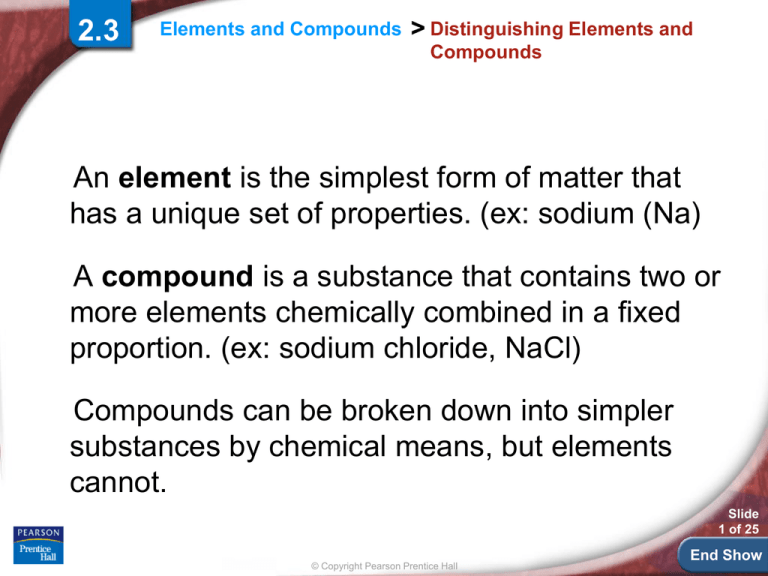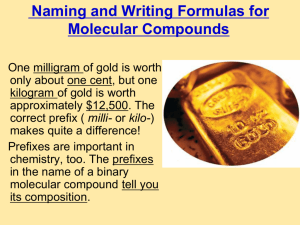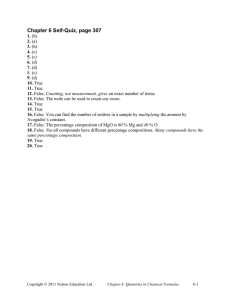
2.3
Elements and Compounds
> Distinguishing Elements and
Compounds
An element is the simplest form of matter that
has a unique set of properties. (ex: sodium (Na)
A compound is a substance that contains two or
more elements chemically combined in a fixed
proportion. (ex: sodium chloride, NaCl)
Compounds can be broken down into simpler
substances by chemical means, but elements
cannot.
Slide
1 of 25
© Copyright Pearson Prentice Hall
End Show
2.3
Elements and Compounds
> Distinguishing Elements and
Compounds
Breaking Down Compounds
A chemical change is a
change that produces matter
with a different composition
than the original matter.
When table sugar is heated,
it goes through a series of
chemical changes.
Slide
2 of 25
© Copyright Pearson Prentice Hall
End Show
2.3
Elements and Compounds
> Distinguishing Elements and
Compounds
The final products of these chemical changes
are solid carbon and water vapor. The following
diagram summarizes the process.
Slide
3 of 25
© Copyright Pearson Prentice Hall
End Show
2.3
Elements and Compounds
> Distinguishing Elements and
Compounds
Properties of Compounds
In general, the properties of compounds are
quite different from those of their component
elements.
When the elements sodium and chlorine
combine chemically to form sodium chloride,
there is a change in composition and a
change in properties.
Slide
4 of 25
© Copyright Pearson Prentice Hall
End Show
2.3
Elements and Compounds
> Distinguishing Substances and
Mixtures
Distinguishing Substances and Mixtures
How can substances and mixtures be
distinguished?
If the composition of a material is fixed,
the material is a substance. If the
composition of a material may vary, the
material is a mixture.
Slide
5 of 25
© Copyright Pearson Prentice Hall
End Show
2.3
Elements and Compounds
> Distinguishing Substances
and Mixtures
This flowchart
summarizes the
process for
classifying matter.
Slide
6 of 25
© Copyright Pearson Prentice Hall
End Show
Slide
7 of 25
© Copyright Pearson Prentice Hall
End Show
Slide
8 of 25
© Copyright Pearson Prentice Hall
End Show
Practice Problems for Conceptual Problem 2.2
Slide
9 of 25
© Copyright Pearson Prentice Hall
End Show
2.3
Elements and Compounds
> Symbols and Formulas
Chemists use chemical symbols to represent
elements, and chemical formulas to represent
compounds. ex: C (carbon), Na (sodium), CO2 (carbon dioxide)
Each element is represented by a one or
two-letter chemical symbol.
Slide
10 of 25
© Copyright Pearson Prentice Hall
End Show
2.3 Section Quiz.
Assess students’ understanding
of the concepts in Section 2.3.
Continue to:
-or-
Launch:
Section Quiz
Slide
11 of 25
© Copyright Pearson Prentice Hall
End Show
2.3 Section Quiz
1. Passing an electric current through a certain
substance produces oxygen and sulfur. This
substance cannot be a(n)
a. compound.
b. mixture.
c. element.
d. solution.
Slide
12 of 25
© Copyright Pearson Prentice Hall
End Show
2.3 Section Quiz
2. Which of the following is a mixture?
a. sodium chloride
b. carbon dioxide
c. sucrose
d. air
Slide
13 of 25
© Copyright Pearson Prentice Hall
End Show
2.3 Section Quiz.
3. The symbol for the element potassium is
a. K.
b. Po.
c. P.
d. Pt.
Slide
14 of 25
© Copyright Pearson Prentice Hall
End Show





